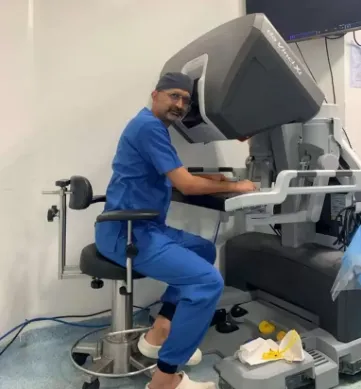
Dr. Sandeep Nayak, formerly the Senior Director of Surgical Oncology at Fortis Hospital in Bangalore, India, and founder of MACS Clinic, is a globally renowned surgical oncologist and pioneer in robotic thyroid and neck surgeries. Known internationally for his groundbreaking techniques in robotic cancer surgery – RABIT and RIA-MIND – he has dedicated his career to improving outcomes for oncology patients while reducing the trauma traditionally associated with these operations.
Now, Dr. Nayak is partnering with Surgical Data Science Collective (SDSC) to explore how artificial intelligence (AI) can further refine and standardize these procedures. With an extraordinary collection of surgical video data, he is working to uncover what differentiates successful surgeries from suboptimal ones and how these insights can be applied globally. Alongside his surgical work, Dr. Nayak offers a valuable perspective on the role of AI in the field of medicine.
He sees AI not as a replacement for surgeons, but as a powerful tool to enhance human skill and safety.
In this spotlight, we’ll explore his pioneering surgical procedures, his collaboration with SDSC, and his thought-provoking views on how AI will shape the future of surgery.
Pioneering Robotic Procedures
The Robotic-Assisted Breast-Axillo Insufflated Thyroidectomy (RABIT) technique, first introduced in 2018, represents a significant advance in thyroid surgery.1 Unlike conventional thyroidectomy, which leaves a visible scar on the neck, RABIT uses small incisions in the breast and underarm. By enabling CO2 insufflation (the use of carbon dioxide gas to inflate body cavities), the approach not only creates better organ and tissue visibility for the surgeon but also reduces robotic arm collisions and improves precision. Clinical results have shown the procedure to be safe, with no nerve injuries, minimal blood loss, and speedier recovery times. Importantly, it sets a new standard for cosmetic outcomes, allowing patients to avoid the stigma of a neck scar while receiving world-class surgical care.
Building on this success, Dr. Nayak went on to develop the Robotic Infraclavicular Approach for Minimally Invasive Neck Dissection (RIA-MIND) procedure.2 Designed for patients requiring lymph node dissection in the neck, this method employs a small, hidden incision below the collarbone, offering superior cosmetic results while ensuring oncological safety. The technique has been widely recognized for its innovation and impact, earning Dr. Nayak the prestigious K Subrahmaniam Robotic Innovation Award from the Vattikuti Foundation. Both RABIT and RIA-MIND exemplify his commitment to combining surgical precision with a patient-centered and sensitive approach, particularly in minimizing visible scarring whenever possible.
.webp)
Standardizing RABIT with AI
Now, Dr. Nayak is leveraging artificial intelligence (AI) and surgical data science to further advance these techniques. Throughout his career, he has amassed a significant repository of surgical video data, representing an extraordinary resource for research and education. With de-identified videos already prepared, his team has begun collaborating with SDSC to analyze and standardize the RABIT procedure on the Surgical Video Platform (SVP). This effort begins with a rich dataset for machine learning models to examine what contributes to successful outcomes and where complications might arise.
For Dr. Nayak, SDSC represents an opportunity to move beyond conventional surgical analysis methods. Traditional approaches have relied on identifying broad phases of surgery, but SDSC’s AI has the potential to detect precise instrument movements and micro-steps within a procedure. This level of detail could reveal subtle variations in technique that affect outcomes, providing surgeons across the globe with actionable insights. By standardizing the RABIT procedure, Dr. Nayak hopes to make it more widely adoptable, thereby reducing complications and ensuring consistently high results regardless of where it is performed.

Will AI Take Over Surgery for Good?
At the heart of this partnership lies Dr. Nayak’s vision for the role of AI in the field of medicine. He believes that AI will never replace surgeons, but will be a powerful tool to enhance a portion of their responsibilities. “As of today, about 5% of jobs in medicine are AI-assisted. Pathology is becoming assisted, and radiology too. What AI can actually do is improve, for example, 20% of your job, and do it a thousand times better. But it won’t be able to do everything that you do.”
Dr. Nayak predicts that, depending on the job role, the figure could rise to 40 or 50% within the next 5 years. However, anything that AI does will always be achieved under human oversight.
As he explains, AI is only as effective as the questions posed to it, and it is the surgeons who must frame those questions, interpret results, and guide care.
For Dr. Nayak, AI’s true potential is in amplifying surgical ability, improving safety, and accelerating learning curves – all while keeping human expertise solidly at the center.
By combining his groundbreaking robotic innovations with SDSC’s advanced video-driven AI, Dr. Nayak is working to standardize his new procedure for the benefit of surgical education and safer operative practice. His journey illustrates how surgical pioneers and data scientists can come together to build the future of cancer care – one where scarless surgery, safer outcomes, and global standardization are made possible through innovation and collaboration.
https://www.youtube.com/@DrSandeepNayak/featured
- Thyroidectomy using robot in India: Macs Clinic [Internet]. 2025 [cited 2025 Sept 10]. Available from: https://macsforcancer.com/thyroidectomy-using-robot-in-india/
- Ria-mind procedure in India: Macs Clinic [Internet]. 2025 [cited 2025 Sept 10]. Available from: https://macsforcancer.com/ria-mind-procedure-in-india/





.png)